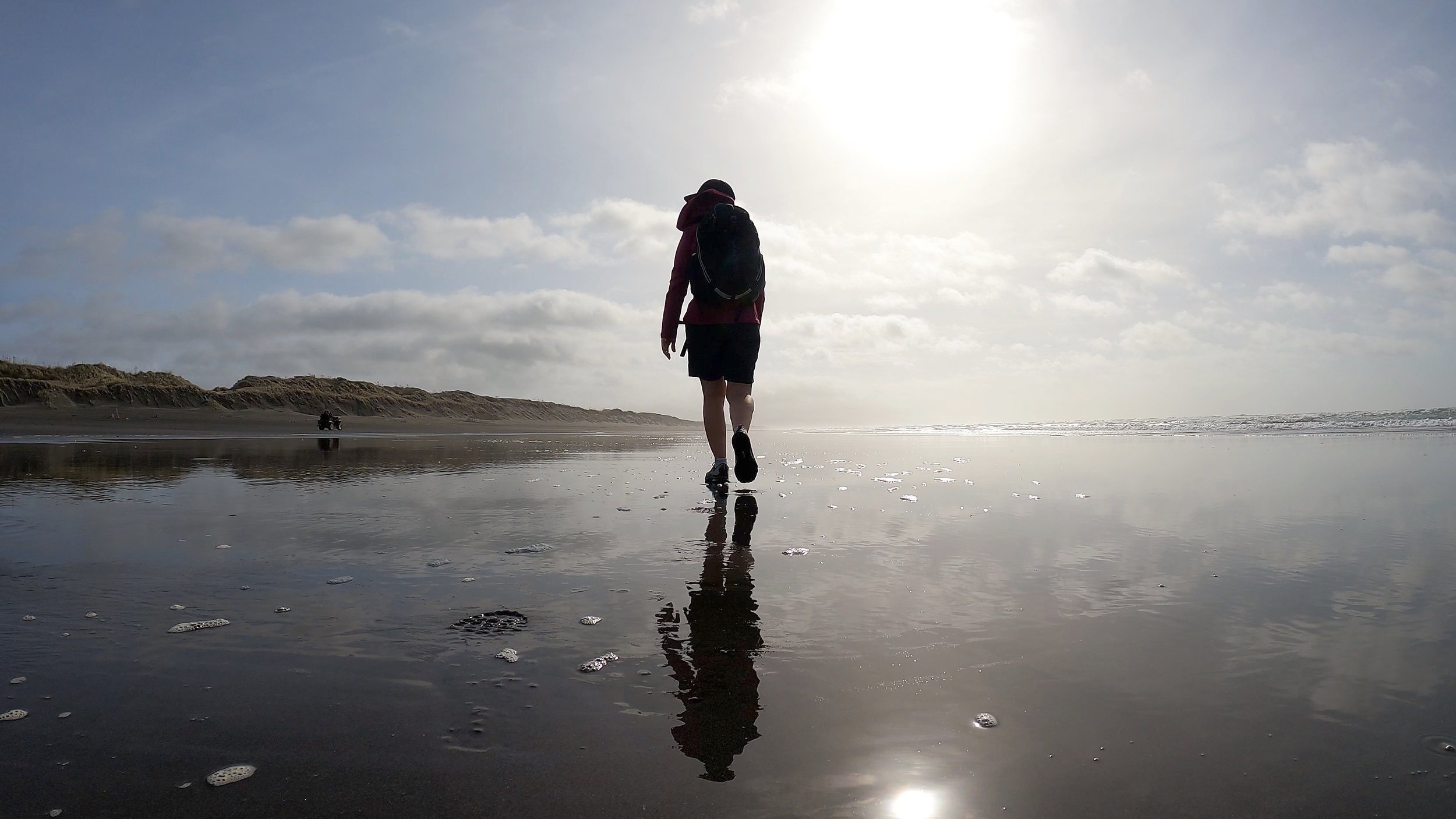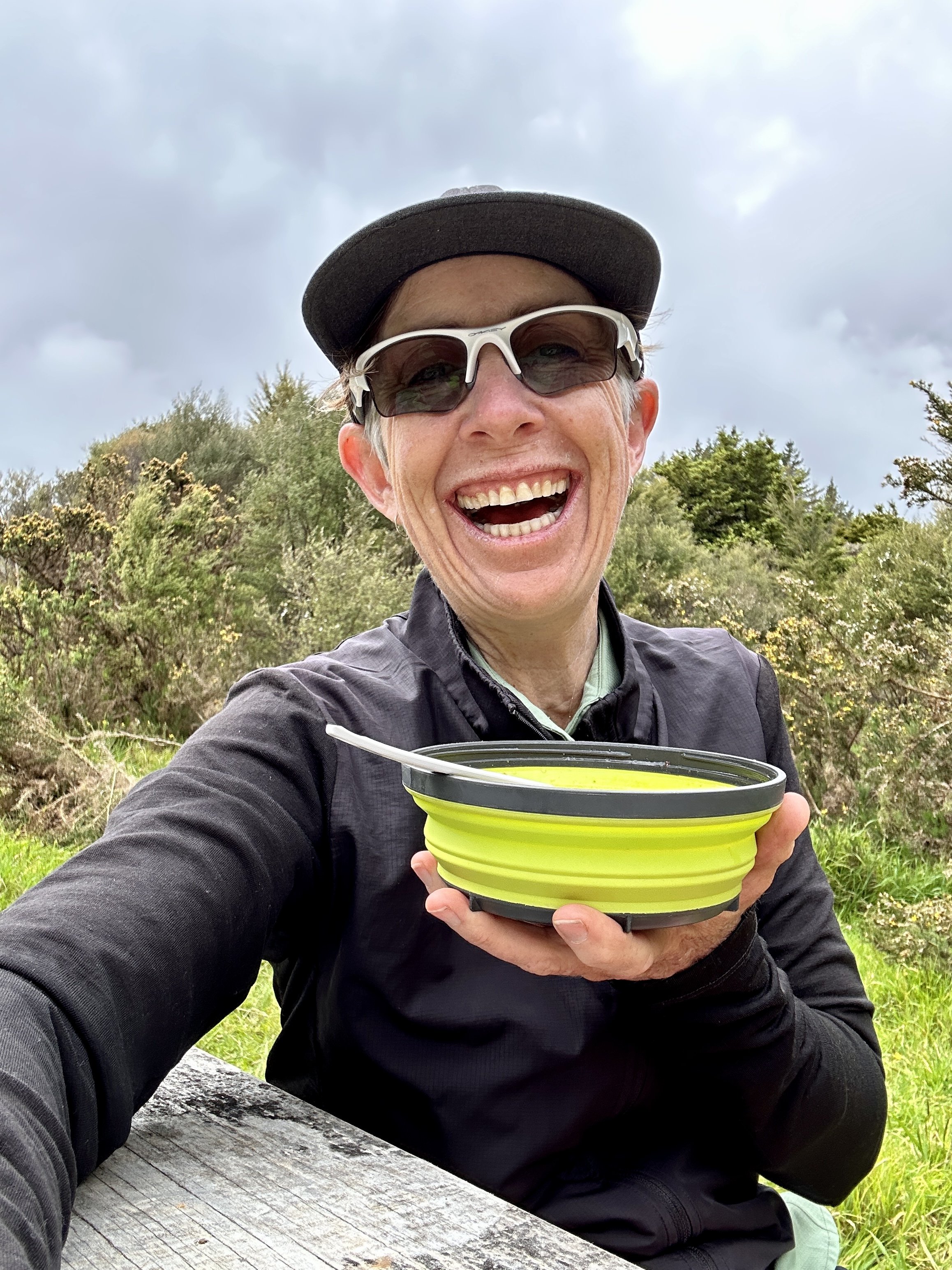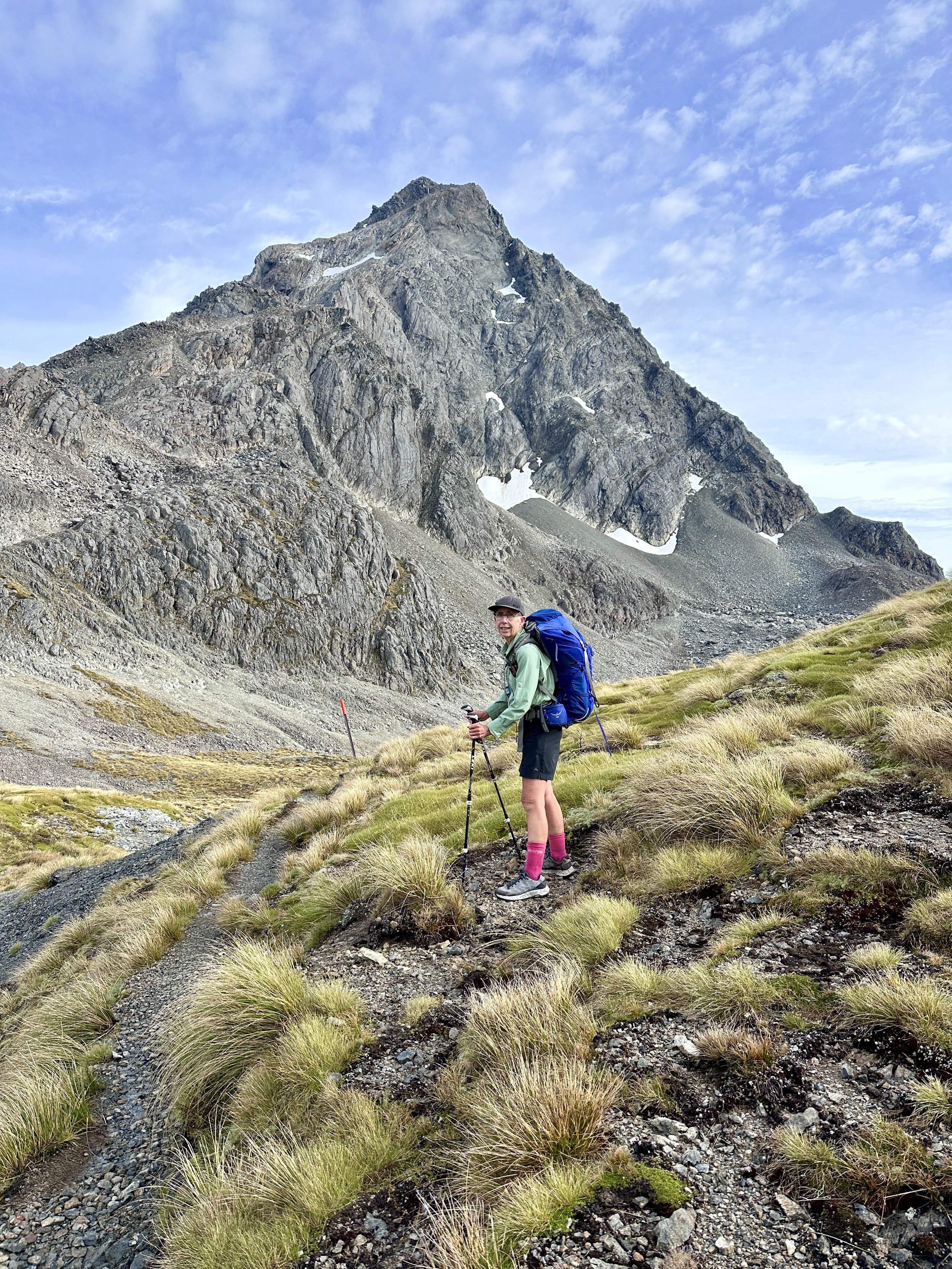
New Zealand’s Long Trail
Te Araroa
Frequently Asked Questions
-
Te Araroa — New Zealand's Trail — is a continuous 3,000 km walking track from Cape Reinga to Bluff.
If you average 25 kilometres a day, it’ll take you 120 days to walk from Cape Reinga to Bluff.
The North Island route is just over 1,600 km long, and the South Island just under 1,400 km
-
The free Te Araroa – The Trail App - allows you to access helpful information, official trail notes and safety alerts from your mobile phone. It also shows campsites, huts, topographical maps and information on trail elevation, even in areas with no internet access.
-
The Te Araroa Trail Angels have an active Facebook Group.
A Trail Angel is someone who provides an awesome service to a weary hiker such as a campsite or a hot drink, meal or even a shower without an expectation of anything in return.
In New Zealand, it is thoughtful to offer a koha (donation) typically equivalent to what you’d pay for a similar service with a commercial operator.
-
All donations to the Te Araroa Trust fund trail maintenance and help everyone and anyone enjoy the hīkoi (walk) of a lifetime.
Offering a monetary Koha (donation) to a Trail Angel is one way to show appreciation of their support to hikers.
A koha is typically equivalent to what you’d pay for a similar service with a commercial operator.
You do not need a permit or pay a fee to walk Te Araroa.
-
Registering for Te Araroa provides information to the Trust which they can use to improve the trail for everyone.
-
Accommodation along the trail is a mix of campsites and huts.
Generally, the North Island is 80% camps and 20% huts, the South island is the opposite, with 80% huts and 20% camps.
Off trail and on town days, your accommodation can be a mix of camping, holiday parks, cabins, motels, backpackers and Trail Angels. It’s up to you and how comfortable you want to be.
-
If you are planning to section hike the Te Araroa, you’ll want to pick the best section.
Best is a relative term, and will depend on your reference point, ability, time available and expectations.
The North Island offers lush forests, beaches, volcanoes, culture, canoe or kayak down a river, mountain ranges and fabulous farmland.
The South Island offers beech and podocarp forests, even bigger mountains with high passes, gold mining history and crystal clear lakes.
-
Yes and no.
Yes, I carry all the food I need up until the next re-supply point, this could be enough for one day, or like in the Richmond Range, enough for eight days.
And No, I don’t carry enough food to last 120 days.
-
Yes and it’s known as a backpack.
Te Araroa is not a guided walk therefore I need to carry everything I want to take.
Ideally, I keep the base weight as low as possible as on top of the weight of those essentials (pack, shelter, sleeping bag, sleeping mat) goes all my food, enough to last to the next resupply point.
-
The best starting date for Te Araroa will depend on whether you’re walking it as a through hike or are section hiking it.
Through hikers generally walk this trail from north to south (SOBO) allowing them to start in the subtropical Northland in the spring (October) and ending in sub-Antarctic Southland at a time when the southern weather is at its most settled in the autumn (March).
If starting from Bluff, north bound hikers (NOBO) typically start in late spring, early summer as it’s more likely that the snows have passed by the time they arrive at the Ranges.
-
For a four to five month trip, expect to spend about $8,000 to $10, 000 to cover your on-trail expenses.
That covers accommodation, transfers, food and some spending when visiting towns along the trail.
Budget for more if you think you’ll need to replace gear as you go.
In the North Island you’ll pay more for accommodation as there’s not the opportunity for free or wild camping whereas in the South Island, you’ll spend more time on the trail than in town or crossing private land.
-
Te Araroa is considered by some as one of the toughest through hikes in the world due to it’s varied terrain and the weather that you’re likely to encounter along the way.
Te Araroa is a demanding walk and it will take you up to three weeks just to get your “trail legs”.
If you can manage the first two weeks you’re well on your way.
Put it this way, Te Araroa is not a walk in the park.
-
Lots!
Walking day in and day out creates a very healthy appetite which has been termed “Hiker Hunger”.
When on trail, food will be some version of freeze dried or dehydrated, either commercial or homemade supplemented by fresh food. The further from town, the less fresh food.
Dehydrated food weights a fraction of the weight of fresh food, doesn’t need refrigeration nor does it get bruised or knocked about squashed in a backpack.
Town days are for filling up on fresh food.
-
Stag Saddle at 1925 metres is the highest point on the entire Te Araroa route.
It’s on Two Thumb Track, South Island.
-
Cape Reinga for South Bound (SOBO) walkers.
Bluff for North Bound (NOBO) walkers.
There’s no offical start or finsih point, just head for the sign at the Cape or Bluff.
-
SOBO: South Bound. Hiking from North to South
NOBO: Northbound. Hiking from South to North
HOBO: how you’ll look after a couple of weeks on the trail
Flip-flop: walking the trail in a non-continuous line, usually with the intention of completing the entire trail
Bounce box: a resupply box that has sometimes-used necessities and can be repeatedly mailed ahead of you on the trail
Cat Hole: a small hole dug in the ground for human waste
FKT: Fastest Known Time – the fastest “official” time that anyone has completed a trail
Hiker Hunger: a continuous, deep hunger that allows you to eat amazing amounts of food in town. This usually happens after a few weeks of hiking as a result of low body fat.
Hiker Midnight: Usually right when it gets dark. The time when most hikers go to sleep.
Hiker Trash: This is a nuanced term. But once you become hiker trash you will know it and you will be proud.
LNT: Leave No Trace is a set of outdoor ethics promoting conservation in the outdoors
Register: a log book found along the trail typically in huts that hikers sign into, and can be used for communication with other hikers
Resupply: refilling food supply once you have run out of food on the trail; can be done from a grocery store, convenience store, or a package mailed to you
Section Hike: hiking sections of a long trail as and when you’ve time
Thru-Hike: hiking an entire long trail in one season
Trail Angel: a person who treats hikers nicely and offers food, drinks, or other helpful resources to them while they hike
Trail family / Tramily : the people that you meet on the trail and hike with. A trail family can change during a hike.
Trail Magic: unexpected food or help on the trail from someone
Zero: hiking zero miles in a day, usually when you go into town and stay 2 nights
-
George Henderson; 49 days 14 hours and 27 minutes. 2019/2020.
So what are you waiting for?
-
Te Araroa Trust offers these notes and maps free of charge HERE.
The maps and notes offer detailed information about accommodation food, transport and resupplying. You canuse them for planning your adventure on Te Araroa.
Alternatively, there’s an entire playlist on the FREEWHEELING KIWI YOUTUBE CHANNEL on preparation for Te Araroa.
-
George Henderson; 49 days 14 hours and 27 minutes. 2019/2020.
So what are you waiting for?
-
View the Freewheeling Kiwi Te Araroa Maps Here
-
The Tasman region provides some of the most challenging tramping on Te Araroa.
The rugged Richmond Alpine Track is well marked but unformed in places.
The summits are consistently above 1500m and the track has many steep, exposed sections and stream crossings.
-
Te Araroa means “The Long Path”
-
The Met Service provide weather forecast for all of New Zealand.
Search for the nearest towns, location or mountain forecast HERE
Note: there is a town in New Zealand called Te Araroa. It is not on the trail.
-
Te Araroa, New Zealand’s Trail, comprises 87 separate trails stretching from Cape Reinga to Bluff.
Link HERE to the maps and description for each of those trails.
Note: there is a town in New Zealand called Te Araroa. It is not on the trail.
-
With the use of a portable power bank.
Watch this video HERE for a full explanation
-
Check out the FREEWHEELING KIWI YouTube Channel for all sorts of Te Araroa related videos HERE
-
The Big Three - backpack, tent and a sleeping bag
Feet - you will need to replace your hiking shoes around every 1,000 - 1,200 kilometres
Clothes - catering for all kinds of weather conditions, at times, all in the same day!
-
It’s hard to know how many town days you will have on your through hike of Te Araroa.
If needing to resupply, you may choose to have a Zero on town days and stay two nights.
-
Cape Reinga
Closest national airport: Kaitaia
Closest international airport: Auckland.
Shuttles can be arranged from Kaitaia to Cape Reinga.
Bluff
Closest national airport: Invercargill
Closest international airport: Queenstown
Shuttles can be arranged from Invercargill to Bluff.
-
No, New Zealand is a hiker’s paradise.
There are no predatory animals or reptiles.
In the South Island, the sandflies will be a challenge, use a repellant.
-
45% of Te Araroa is on conservation land, other parts cross private farms and then there’s the road walking and accommodation.
It’s best to leave your dog at home.
-
Watch this video on how I navigate Te Araroa HERE
-
You can do if you organise the group, either starting with friends or making friends as you go along and forming a Trail Family / Tramily.
Many people walk Te Araroa solo.
-
New Zealand has a very good publicly funded emergency and hospital systems.
You will be looked after.
-
No, I’m not a hunter and don’t need the extra weight.
However, if you are a hunter, I’m happy to share your game meat so long as I don’t have to prepare it myself.
-
Te Araroa is a walking trail.
Sections of it can be ridden by bike or horse but not many so leave them at home.
Walking 3000 kilometres from Cape Reinga to Bluff
-
Te Araroa Blog
Daily updates direct from the Te Araroa Trail.
I created a video for each of the 133 day that it took me to walk Te Araroa. You’ll see the highlights as well as the lowlights. This is an authentic account of my experience walking New Zealand’s Long Trail
-
Te Araroa Preparation
How to prepare to hike Te Araroa, New Zealand’s Long Trail.
Videos showing the steps I took to prepare for my thru hike of Te Araroa, all the way from Cape Reinga, in the North Island all the way to Bluff at the bottom of the South Island
-
Te Araroa FAQ
Te Araroa FAQ
Here are my most frequently asked questions about Te Araroa, New Zealand’s Long Trail.
Sign up to my EPIC Adventure Newsletter
Do you want free travel tips, inspiring stories, early access to my A to Z Guides and be the first to know when I announce a new Group Trip?
Ready to join the Adventure?
Hi and welcome to my website. I’m Sharon Evans and I’ve a passion for travel that provides adventure, challenge, nature and inspiration.
I’m a professional storyteller here and on YouTube, Instagram, Facebook, Threads and TikTok with many thousands of followers across my channels.
Join me as I share my authentic experiences from around the world 💚



